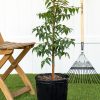Description
The Palm That Makes a Presidential StatementWashington Robusta is known by several names, such as Washington Palm and Mexican Fan Palm. This plant is a flowering species of the famous palm family of Arecaceae. Despite its name, the plant is not native to the United States or even Washington.Washington palm is loved because of its unique leaves and easy-to-grow quality. People can grow it at home to create an aesthetic ambiance or in a park for shade. The best part is that this plant can grow 2 to 4 feet per year. Washington Robusta is native to northwest Mexico and Baja California Peninsula. This plant is reportedly naturalized in California, Florida, Texas, Hawaii, France, Italy, Israel, parts of the Canary Islands, etc. It was named after US president George Washington. As it is native to Mexico, the plant is popular with the following names: Mexican Washington Skyduster Mexican fan palmCareWashington Palm can reach more than 98” if you give them good care. Here are some things that you need to consider while caring. LightIf you want to grow them well, you need to keep them under the full sun. However, they can also thrive under shade. Fortunately, Mexican fan palms are also winter hardy, and you don’t need to worry about them in freezing temperatures. Your plant can tolerate temperate of -8° C or 18° degrees Fahrenheit. SoilThis plant can grow in several types of soils but healthily grows in fertile soils only. These lovely plants can grow in slightly acidic or alkaline soil. You need to check that the soil is well-draining, as your Washington Palm can’t tolerate waterlogged or soggy soils.FertilizerThe fertilizers you use for the Washington Robusta depend on the soil. But in general, you need to use 1 ½ pound of 8-1-10-4 palm tree fertilizer for 100 sq feet of area. You also need to apply fertilizer every three months. In the case of fertilizers, make sure that your fertilizer contains a good portion of phosphorous, nitrogen, micronutrients, and potassium. Also, it’s best to use controlled-release fertilizer every month when they are growing.WaterThough Mexican Fan Palm is considered a desert plant, it thrives in areas with subsurface or permanent surface water. In other words, it doesn’t have high drought tolerance until it grows fully. Water your plant moderately throughout the year, except for freezing days. Try to keep your tree completely dry in cold weather. Common IssuesSince these Mexican plants have a habit of living in difficult conditions, you have to worry less about pests and diseases than other plants. PestsWashington Robusta is susceptible to several pests such as scales, aphids, spider mites, and mealybugs. You can control pests by using insecticidal soap spray. If you plan to have a good height that makes it impossible to reach every leaf, you can go for the systemic insecticides drenched in plant soil. Just make sure to check the instruction before using them. DiseaseThese plants are highly susceptible to diseases, but potassium deficiency can lead to some problems. For instance, you can notice leaf tip necrosis, premature death of some levees, and lead discoloration. Don’t remove the discolored or partially necrotic leaves, as they provide potassium to your plants. Poorly draining soil or excessive watering can lead to root decay and rot. So, water your plants accurately. PruningYour Washington Palm surely needs a pruning session once in a while. The older and dried palm leaves serve as a home to many harmful creatures like rats. Therefore, it’s vital to prune the plant to get rid of dead fronds. But the plants themselves will begin to shed leaves when they are 30’ feet. This means you don’t need to prune larger plants. PropagationWhether you want to grow Washington Palm in your garden or outside your office, you can begin the journey with the plant seed. They will easily grow through seeds and don’t require great effort. When you keep them warm and uniformly moist, between 29° and 35° C, the seeds will germinate in less than two weeks. Potting/ ReportingYou can plant these species directly in a pot or ground. Spring and early summers are the best time to plant them, as they will get excellent sunlight to grow. Don’t plant your tree deep in the ground than the growing point of the tree. Remove or add soil as needed.





